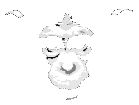It’s already been demonstrated on this site that there are photographs of the moon taken during Apollo that could not have been taken from Earth. What this page will show is that the photographs and video taken from orbit show another area of complete consistency with the stated record: the location of the lunar terminator.
Terminator photography was a feature of all missions in one form or another, and in longer missions the terminator can be seen to move consistent with that passage of time.
To demonstrate this feature I’ll use LRO’s sunlit area feature a in combination with the records at the Apollo Flight Journal and Apollo Lunar Surface Journal, and the positions of Apollo photographs in my Google Moon kmz files. With all of the photos, TV and 16mm footage available, it’s worth bearing in mind that while the LRO can show us exactly where the terminator is, the imagery from Apollo is showing us where the camera’s ability to record the lunar surface stops as light levels fall. What it will show us, however, is that the position of that apparent terminator is consistent with what we should be seeing, and moves over time in a consistent way.
Let’s see what we can find.





